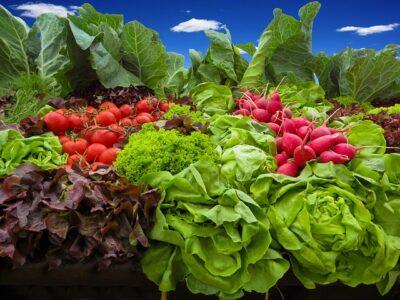Lasagna gardening is a great, time-saving, no-ill, easy form of gardening. With a little start-up work, you can create an almost completely weed-free garden of rich soil in which your plants will thrive.
A lasagna garden, as its name suggests, is made up of layers. These layers need time to break down, so it’s best to put your layers on the ground in the fall and let the garden cook over the winter months to give it a jumpstart on the composting. Allowing time for decomposition over the winter is key to getting a great and easy start in the spring. Lasagna gardening mimics what happens every year in the forest. Layers form, begin to break down over the winter months, and then in spring, plants grow, continuing to break down the layers to release more nutrients. It’s a beautiful cycle.
So, first things first: You need to lay down those layers. Pick your plot and procure enough cardboard to lay down over the entire area. This layer is going to be the barrier that keeps those pesky weeds and grass away. And, here’s an awesome perk: You don’t need to till or dig up any part of the plot. Just go ahead and lay your cardboard down over the grass or old garden plot. Then pull out your hose and water the cardboard until it’s nice and soaked. Or, if rain is coming, run out there and put the cardboard down quick and let nature do your work for you. (If you use your hose, be sure to drain it out well so it doesn’t freeze.)
Next, start adding layers. This first layer needs to be water absorbent, so think leaves, peat moss, straw, etc. If you time this right, your yard should be replete with lots of leaves just waiting for you to make use of them. Rake those leaves over the area and spread them out. This layer needs to be about two to three inches thick. If you have extra leaves, then hold some back. You’ll use them for another layer.
Get The Best Deals On Non-GMO Heirloom Seeds Right Here!
Time for your first green layer. Mow your yard for the last time this fall and spread the grass clippings out on your lasagna garden plot. If you don’t have enough grass clippings, look for other “green” stuff. Any trimmings from this year’s garden, veggie scraps from the kitchen, etc.
Keep adding layers until you’ve got about two feet of layers. Lay down a brown layer, then a green layer, then a brown layer and so on. Compost, coffee grounds and filters, tea bags, sawdust, shredded newspaper, and fruit and vegetable scraps from your kitchen all are great layer ideas. Stay away from meat, bones, dairy products and dog and cat feces, as these can harbor pathogens (not something you particularly want in your garden). Also, steer away from including weed seeds in your layers, as these will just come up in the spring.
Story continues below video
Here are a couple of quick tips:
- To find cardboard boxes, stop at a grocery store and ask. They usually have leftovers and are more than willing to share.
- Avoid having leaves as your top layer. They tend to blow away in wind. If you have a way of shredding them, they will be a lot less prone to blowing, too.
- Putting kitchen scraps into your garden can be an invitation to wild (and domestic) animals to show up for a dinner. Consider putting up a fence, or laying a tarp down over your lasagna garden and weighting the edges with rocks or cinder blocks. You also can put a top layer of mulch down to cover all the yummy stuff and discourage foragers.
- Plan to add more layers in the spring if you will be planting tomato plants or other “heavy” plants that need deeper soil for their roots to hold onto. As the layers grow each year and the soil becomes deeper, this will no longer be necessary.
- If you’re having trouble coming up with stuff for your “green” layer, you can use alfalfa pellets. Farm supply and feed stores carry these.
- If you have the resources, a pile about three feet high (rather than just two feet) will cook better over the winter.
- Finish off your garden plot by topping with straw and/or a tarp. This will help insulate the pile from the cold (as heat is very important for decomposition) and slow down its drying out. Moisture is crucial for the breakdown of everything. You want your plot to feel like a wrung-out sponge. If it gets dry, pull out your hose and water the pile. (Of course, be sure to drain out your hose well when you’re done so it doesn’t freeze.)
Because you started your garden this fall, you have more flexibility with what can be put down, as some decomposition will take place through the winter. Decomposition is much slower in colder temperatures, but if you have at least two (better if three) feet of layers, and you cover with a tarp or straw, the pile will maintain some heat and “cook” over the winter.
Come spring and summer time, the plants’ roots will dig down and continue decomposing the layers, pulling out the nutrients at just the right speed for a hearty and heavily producing garden.
Have you ever grown a lasagna garden? What advice would you add? Share your tips in the section below:
Learn Dozens Of All-Natural Gardening Secrets. Read More Here.
 Off The Grid News Better Ideas For Off The Grid Living
Off The Grid News Better Ideas For Off The Grid Living




